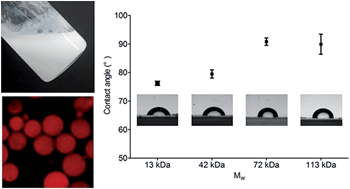Systematic studies of Pickering emulsions stabilized by uniform-sized PLGA particles: preparation and stabilization mechanism†
Abstract
Pickering emulsions stabilized by solid particles have been widely studied in the past decades due to improved stability and reduced use of small molecular surfactants. Recently, the application of Pickering emulsions in pharmaceutics has been attracting increasing attention but very limited practical use has been demonstrated, because most of the investigated particles possess poor biodegradability, which is inappropriate in pharmaceutics. Some reported biodegradable particles were too hydrophilic to stabilize emulsions, which needs further particle modification or additional surfactants. Fortunately, biodegradable poly(D,L-lactic-co-glycolic acid) (PLGA) with tunable hydrophilicity makes itself a promising material to prepare Pickering emulsions. However, the mechanism of emulsion stabilization still remains unknown. Moreover, fabrication of large amounts of uniform-sized and size-controlled PLGA particles by traditional methods is very difficult, which further increases the difficulty to perform the research. In the present study, we applied Shirasu Porous Glass (SPG) premix membrane emulsification to solve this problem. The stabilization mechanism of Pickering emulsions stabilized by PLGA particles was systematically studied for the first time. The factors including oil type, particle properties, concentration, molecular weight (Mw) and oil–water volume ratio were analyzed through particle wettability and interfacial influence. We found that octanol was an appropriate oil type, and its small particle size, high particle concentration and high Mw were favorable for emulsion stability. By changing the oil–water volume ratio, stable emulsions were also readily achieved. These studies proved that Pickering emulsions stabilized by PLGA particles had wide potential applications in pharmaceutics and tissue engineering.


 Please wait while we load your content...
Please wait while we load your content...